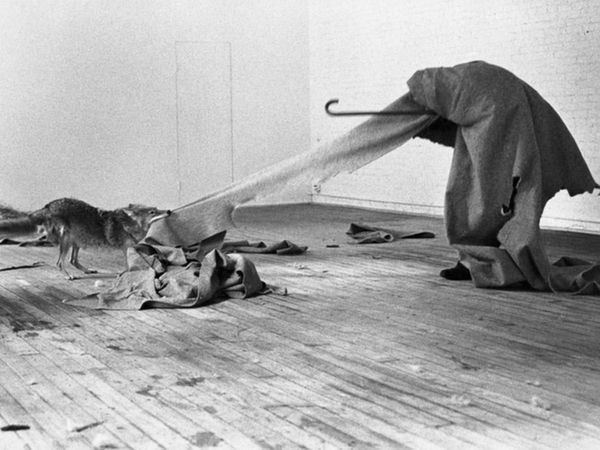Andres Veiel's timely and precise documentary Beuys, edited by Stephan Krumbiegel and Olaf Voigtländer, takes us on a journey with Joseph Beuys through archival footage, photos, and personal remembrances from Caroline Tisdall, Rhea Thönges-Stringaris, Klaus Staeck, Johannes Stüttgen, and Franz Joseph van der Grinten.
During the late 1940s, Beuys assisted wildlife documentarian Heinz Sielmann in building structures in nature to hide the cameras for his films about local fauna. Animals feature prominently in his later works and Beuys, one of Germany's Green Party founding fathers, remains the most important artist questioner of the boundaries on our communication with nature. In the performance piece How To Explain Pictures To A Dead Hare from 1965, he did precisely this. He elucidated artworks in a gallery space, whispering to the dead hare he carried around in his arms while a crowd of spectators pressed their noses at the gallery windows.
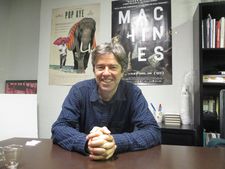 |
| Beuys director Andres Veiel: "He was telling us about our limitation of our senses." Photo: Anne-Katrin Titze |
In 1974 Beuys visited the US without touching the ground - he was transported, wrapped in felt, by ambulance and stretcher to the René Block Gallery in SoHo - or interacting with anyone except a coyote. For I Like Amerika and Amerika Likes Me, he spent eight hours over three days only communicating with the animal, holding his shepherd's staff, sleeping on straw. Veiel includes some of the footage and a number of stills in his documentary. It is mesmerizing to watch the coyote work at shredding the blanket and how this highly symbolic endeavor is unmistakably grounded in the real relationship the two are building.
A third animal, joining hare and coyote, in the first installment of my in-depth conversation with the filmmaker was the deer, or, more specifically, the deer sounds which Beuys decided to utilise to great effect for an opening speech at the academic institution where he taught.
In 1982, Beuys initiated the land-art project 7000 Oaks for Documenta 7 in Kassel, in which each of the newly planted trees was partnered with a basalt stone. The relationship between the two elements changes with time. Our use of new beginnings, the symbolism of the oak, stagnation and rebirth all may and should come to mind. After Beuys' death in 1986, along a block on West 22nd Street in New York's Chelsea district, the sculpture project was continued by Dia Art Foundation in homage to the artist, using linden, bradford pear, gingko, and sycamore trees besides the mighty oak teaming up with the basalt stones.
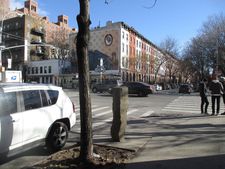 |
| Joseph Beuys 7000 Oaks at 10th Avenue and West 22nd Street in New York Photo: Anne-Katrin Titze |
Anne-Katrin Titze: Beuys doing I Like Amerika And Amerika Likes Me - the clips are fascinating to see again, the still photographs and some of the movements in his interaction with the coyote. I can't think of anything like this today in the art world. It's not just the myth or just America. Our basic nature what it means to be human is in this for me.
Andres Veiel: Did you see it before the film as a whole, I Like Amerika?
AKT: A long time ago. I saw it in the late Nineties. Someone was doing a project here in New York called I Bite America And America Bites Me [Oleg Kulik at Deitch Projects], some parody of it that I went to in SoHo. In that context I watched the original Beuys piece.
AV: For me, for us, it was a challenge, this mixture of moving images and photos. We tried to use both languages or textures of material. Sometimes we discovered in still images the way that in a very crucial moment Beuys and the coyote look at each other. And you really feel they found a language, a very specific language of communication. Again it's a question of empathy. It's not that this is the animal and this is the human being in a way.
Caroline [Tisdall] put it like this: The coyote was the one who influenced the rhythm of all the elements of this performance. One tried to find out via empathy who's the animal and how you can find a common language. That's the development that we found in the footage. And it was very good to have the photos because sometimes you could find in a photo something where the moving images of a film were just passing it quickly. With a photo we could stop it and say, look at it.
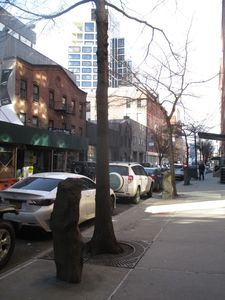 |
| 7000 Oaks along West 22nd Street between 10th Avenue and West Street Photo: Anne-Katrin Titze |
In the beginning we didn't know how to make the film. I was starting from scratch. I had no idea. I started very traditionally making interviews. I never met him in person. Talking to people who were with him, I felt maybe something of the spirit, the atmosphere, seeing something in the eyes of someone grabbed a piece of Beuys.
AKT: There is a connection to nature from the coyote to the 7000 Oaks to the founding of the Green Party. I read that he also worked on nature documentaries with Heinz Sielmann.
AV: Sielmann, yes, you are right.
AKT: In 1948, '49. And they knew each other from their studies?
AV: Not only from their studies. It's interesting because Beuys was already in the Luftwaffe in Posen. Sometimes when he had some hours of spare time he went to the University in Posen and Sielmann too. Sielmann was also in the Luftwaffe and there they met. They re-met after the war and Sielmann started to make these films on animal life. And Beuys was his assistant.
AKT: Did you get a chance to see the documentaries? Do they still exist?
AV: No, I never saw them. Maybe. I think there's a Sielmann Foundation.
AKT: He was a neighbour.
AV: I see!
AKT: Heinz Sielmann and Beuys I never connected the two. It would be fascinating to see these films, wouldn't it? Which animals, too. Was it coyotes?
AV: No, no, it was in Germany. They never went abroad [together]. I think I read something about watching specific birds in post-war Germany. I don't know what exactly.
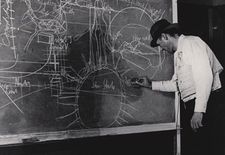 |
| Joseph Beuys deer blackboard drawing - Andres Veiel: "He had this very specific affinity to even the language of animals. It was not only that he wanted to imitate a deer." |
AKT: Let's stay with animals for a moment and move on to the hare. There are other ways to go through your film but animals could be one. Tell me about the editing of How To Explain Pictures To A Dead Hare. I like that you went for the parts where you have to smile, at least. Although you have the beautiful scene with the grunts where someone says "People were too scared to laugh." They are meaningful and also very funny. I think Beuys also had a great sense of humour.
AV: Yeah, and that was for me a very important point, a discovery in fact. I went to many shows and exhibitions and even to Documenta in 1977 but going now into the archive footage I discovered the hare in a way. And I discovered the humour which is connected with the hare. Because the hare is not going straight, he is always vanishing, showing up again, he is running not straight but in a zigzag.
This means you always get surprised and humour means that somebody makes a little jump. Not going straight, he is surprising by a subtle change of the meaning, of the intention. And that's the hare. Beuys, in fact in an interview when he was here in New York, was asked "Who are you? Please introduce yourself because in the US nobody knows you. Please introduce yourself." And then he said "I'm Joseph Beuys, I'm a hare." Full stop and that's it.
AKT: Perfect. Hares are tricksters in international folktales.
AV: I think it's funny because a decade later after How To Explain Pictures To A Dead Hare, he explained that even a dead hare has more abilities in a way than a human being. He was telling us about our limitation of our senses. How we limit them and that we think we are the crown of creation but in fact an animal with all its abilities and capabilities has other senses.
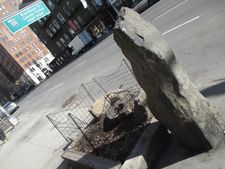 |
| 7000 Oaks tree cut down with damaged basalt stone Photo: Anne-Katrin Titze |
And even a dead hare has more senses than we ever can expect to have. And for me, of course it's humorous but in the same time in the humor there's a spine. It hits you. It provokes our idea of superiority, of sovereignty. Even in myself he produced this oxygen all the time. I grabbed him in a way, and he becomes the hare and he is escaping, and that's why I had to work for so long on this film.
AKT: Some of the faces of the people gawking at his performance and especially German journalists - it clearly comes across that a dead hare has more sense in him. The horror of some of the questions you included! The smugness towards him! I'm sure, it's also international but anyway.
AV: The arrogance! It's very German.
AKT: Some German-ness that just made my skin crawl.
AV: Yeah. That's a reason why you left Germany, I think.
AKT: Yes. Truthfully, yes.
AV: I can understand.
AKT: Part of it was exactly those people. You show several clips from a panel discussion with Beuys. You don't identify the repulsive man on the panel who says sarcastically "I am so amused" by Das Rudel [The Pack (Volkswagen bus with the 24 sleighs packed with felt blankets)]. And he asks Beuys why he didn't use a baby pram. Who is he? What is this panel?
 |
| Andres Veiel on using Caroline Tisdall's photos: "One tried to find out via empathy who's the animal and how you can find a common language." Photo: Jörg Jeshel |
AV: The guy talking about the baby pram is Arnold Gehlen. He was a right-wing social scientist. And for him Beuys was just this stupid idiot and he thought he could just push him aside with one notion, one remark. And show the public, look at this funny stupid artist idiot. But Beuys was winning the game.
AKT: And the Swiss man was Max Bill?
AV: The Swiss man was Max Bill.
AKT: You decided not to identify them.
AV: Because 99% are not interested in who they are. They've been dead for decades and not really famous. And even a name doesn't tell the background.
AKT: I am asking because I like that you exposed them. You show the stupid questions and what Beuys was up against.
AV: What he was up against, first, and that it was another period. I think we have to explain the period where art was still a provocation. It was primetime, this panel discussion - 8:15 PM, after the Tagesschau [the evening news program everyone watched religiously]. It's unbelievable today when you think about TV and this crap.
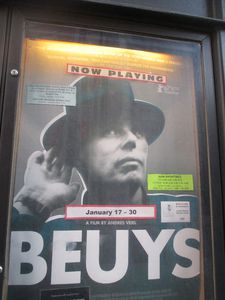 |
| Beuys poster at Film Forum in New York Photo: Anne-Katrin Titze |
To have on this level a talk show talking about provocation and art and the interrelation between the two notions. And the second reason, that art was so provocative that TV took the issue and put it into a talk show. You think today, okay we have Ai Weiwei and some artists who are very political. And we have in Germany artists who are internationally known like Richter or …
AKT: … Anselm Kiefer…
AV: Anselm Kiefer, yeah. But the headlines are the pieces of art that are sold at Sotheby's for 40 million or 50 million at an auction. This is why artists are in the evening news.
AKT: It's about money - which was exactly Beuys's point. If you don't address money and the way we deal with it, nothing will change.
AV: The monetary system, yeah. He was very strict and very concrete in criticising the art market. He hits the point. That's the crucial issue - it's only a question how to sell and how much and to build up in terms of a ranking. What is my ranking in terms of shows, in terms of selling and buying? No one knows when the bubble will burst and art is number one to invest the money. So we get these auctions and all the stupidity. Beuys was criticizing it in the Seventies. He was ahead of his time.
AKT: You show him talking about a post-capitalist and post-communist society. Post-capitalist - a lot of people can't even imagine that this is a possibility today anymore! Post-capitalist? What is that supposed to look like? It's unimaginable for many. I want to talk a bit about the grunt speech Beuys gave. Hearing him I had to think of the character of Merde in Leos Carax's Holy Motors. Do you remember?
AV: Not really, you have to help me. I've watched the film but it's too long ago.
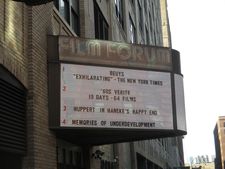 |
| Beuys on Film Forum marquee Photo: Anne-Katrin Titze |
AKT: Denis Lavant plays this character, also in a section of Tokyo!, who just grunts as he walks through the cemetery, eating flowers from the graves and then he encounters Eva Mendes doing a photo shoot. He grumbles in that special speech he has - I interviewed recently Denis Lavant so I had this on my mind. I thought suddenly, could that speech pattern have been influenced by Beuys?
AV: It could, it could. He had this very specific affinity to even the language of animals. It was not only that he wanted to imitate a deer. Again, like the metaphor with the dead hare he wanted to show by the language of a deer - it tells us much more.
AKT: It is the language of a deer?
AV: Yes, you mean this opening speech of the Akademie [Staatliche Kunstakademie Düsseldorf]?
AKT: Yes. I didn't know from what animal the sound was.
AV: It's a deer! Yes, and the deer shows up in many paintings and drawings of his. We have this ambivalence of the hare and we have the deer.
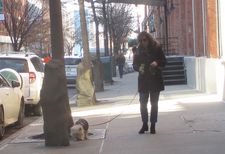 |
| A Joseph Beuys 7000 Oaks admirer Photo: Anne-Katrin Titze |
AKT: Very Disney too, you know, Bambi in the forest. I wouldn't put that layer beyond him.
AV: It's also a holy animal. The deer in mythology. The deer sound was a provocation but at the same time it was a message. I think people misunderstand when they only reduce it to a provocation. It was also a message: Don't spend your time with all this bullshit of nice, friendly talking. We have other levels of communication which are much more important.
Beuys is screening at Film Forum in New York through January 30.








